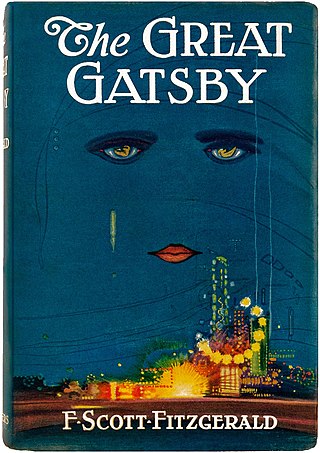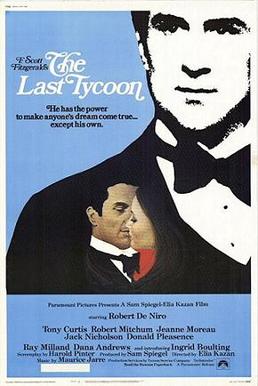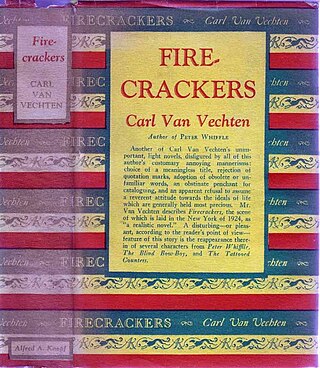
The Great Gatsby is a 1925 novel by American writer F. Scott Fitzgerald. Set in the Jazz Age on Long Island, near New York City, the novel depicts first-person narrator Nick Carraway's interactions with mysterious millionaire Jay Gatsby and Gatsby's obsession to reunite with his former lover, Daisy Buchanan.

Thomas Clayton Wolfe was an American novelist of the early 20th century.

Zelda Fitzgerald was an American novelist, painter, playwright, and socialite. Born in Montgomery, Alabama, to a wealthy Southern family, she became locally famous for her beauty and high spirits. In 1920, she married writer F. Scott Fitzgerald after the popular success of his debut novel, This Side of Paradise. The novel catapulted the young couple into the public eye, and she became known in the national press as the first American flapper. Due to their wild antics and incessant partying, she and her husband became regarded in the newspapers as the enfants terribles of the Jazz Age. Alleged infidelity and bitter recriminations soon undermined their marriage. After traveling abroad to Europe, Zelda's mental health deteriorated, and she had suicidal and homicidal tendencies which required psychiatric care. Her doctors diagnosed Zelda with schizophrenia, although later posthumous diagnoses posit bipolar disorder.

Save Me the Waltz is a 1932 novel by American writer Zelda Sayre Fitzgerald. It is a semi-autobiographical account of her early life in the American South during the Jim Crow era and her tempestuous marriage to novelist F. Scott Fitzgerald. She composed the work while a patient at Johns Hopkins Hospital's Phipps Clinic in Baltimore, Maryland. As part of her recovery routine, she spent at least two hours a day writing a novel. She sent the manuscript to her husband's editor, Maxwell Perkins. Although unimpressed by the manuscript, Perkins published the work in order for Fitzgerald to repay his financial debt to his publisher Scribner's.

Samuel Hopkins Adams was an American writer who was an investigative journalist and muckraker.

This Side of Paradise is the debut novel by American writer F. Scott Fitzgerald, published in 1920. It examines the lives and morality of carefree American youth at the dawn of the Jazz Age. Its protagonist, Amory Blaine, is an attractive middle-class student at Princeton University who dabbles in literature and engages in a series of romances with flappers. The novel explores the theme of love warped by greed and status-seeking, and takes its title from a line of Rupert Brooke's poem Tiare Tahiti.

The Last Tycoon is a 1976 American period romantic drama film directed by Elia Kazan and produced by Sam Spiegel, based upon Harold Pinter's screenplay adaptation of F. Scott Fitzgerald's unfinished novel The Last Tycoon. It stars Robert De Niro, Tony Curtis, Robert Mitchum, Jack Nicholson, Donald Pleasence, Jeanne Moreau, Theresa Russell and Ingrid Boulting.

Tender Is the Night is the fourth and final novel completed by American writer F. Scott Fitzgerald. Set in French Riviera during the twilight of the Jazz Age, the 1934 novel chronicles the rise and fall of Dick Diver, a promising young psychiatrist, and his wife, Nicole, who is one of his patients. The story mirrors events in the lives of the author and his wife Zelda Fitzgerald as Dick starts his descent into alcoholism and Nicole descends into mental illness.

A Lost Lady is a 1923 novel by American writer Willa Cather. It tells the story of Marian Forrester and her husband, Captain Daniel Forrester, who live in the Western town of Sweet Water along the Transcontinental Railroad. Throughout the story, Marian—a wealthy married socialite—is pursued by a variety of suitors and her social decline mirrors the end of the American frontier. The work had a significant influence on F. Scott Fitzgerald's 1925 novel, The Great Gatsby.

The Beautiful and Damned is a 1922 novel by American writer F. Scott Fitzgerald. Set in New York City, the novel's plot follows a young artist Anthony Patch and his flapper wife Gloria Gilbert who become "wrecked on the shoals of dissipation" while excessively partying at the dawn of the hedonistic Jazz Age. As Fitzgerald's second novel, the work focuses upon the swinish behavior and glittering excesses of the American social elite in the heyday of New York's café society.

Jay Gatsby is the titular fictional character of F. Scott Fitzgerald's 1925 novel The Great Gatsby. The character is an enigmatic nouveau riche millionaire who lives in a luxurious mansion on Long Island where he often hosts extravagant parties and who allegedly gained his vast fortune by illicit bootlegging during prohibition in the United States. Fitzgerald based many details about the fictional character on Max Gerlach, a mysterious neighbor and World War I veteran whom the author met while living in New York City during the raucous Jazz Age. Like Gatsby, Gerlach threw lavish parties, never wore the same shirt twice, used the phrase "old sport", claimed to be educated at Oxford University, and fostered myths about himself, including that he was a relation of the German Kaiser.

Gentlemen Prefer Blondes: The Intimate Diary of a Professional Lady (1925) is a comic novel written by American author Anita Loos. The story follows the dalliances of a young blonde gold-digger named Lorelei Lee "in the bathtub-gin era of American history." Published the same year as F. Scott Fitzgerald's The Great Gatsby and Carl Van Vechten's Firecrackers, the work is one of several famous 1925 American novels which focus upon the insouciant hedonism of the Jazz Age.

Daisy Fay Buchanan is a fictional character in F. Scott Fitzgerald's 1925 novel The Great Gatsby. The character is a wealthy socialite from Louisville, Kentucky who resides in the fashionable town of East Egg on Long Island during the Jazz Age. She is narrator Nick Carraway's second cousin, once removed, and the wife of polo player Tom Buchanan, by whom she has a daughter. Before marrying Tom, Daisy had a romantic relationship with Jay Gatsby. Her choice between Gatsby and Tom is one of the novel's central conflicts. Described by Fitzgerald as a "golden girl", she is the target of both Tom's callous domination and Gatsby's dehumanizing adoration. The ensuing contest of wills between Tom and Gatsby reduces Daisy to a trophy wife whose sole existence is to augment her possessor's socio-economic success.

Francis Scott Key Fitzgerald was an American novelist, essayist, and short story writer. He is best known for his novels depicting the flamboyance and excess of the Jazz Age—a term he popularized in his short story collection Tales of the Jazz Age. During his lifetime, he published four novels, four story collections, and 164 short stories. Although he achieved temporary popular success and fortune in the 1920s, Fitzgerald received critical acclaim only after his death and is now widely regarded as one of the greatest American writers of the 20th century.

Firecrackers. A Realistic Novel is a 1925 novel by American author Carl Van Vechten. It is one of several fictional works published that same year which assayed the temerity and hedonism of the Jazz Age including F. Scott Fitzgerald's The Great Gatsby and Anita Loos' Gentlemen Prefer Blondes.

Flaming Youth is a 1923 American silent drama film directed by John Francis Dillon and starring Colleen Moore and Milton Sills, based on the novel of the same name by Samuel Hopkins Adams. The film was produced and distributed by Associated First National. In his retrospective essay "Echoes of the Jazz Age", writer F. Scott Fitzgerald cited Flaming Youth as the only film that captured the sexual revolution of the Jazz Age.

Francis Scott Key Fitzgerald was an American author of novels and short stories, whose works are the paradigmatic writings of the Jazz Age. He is widely regarded as one of the greatest American writers of the 20th century. Fitzgerald is considered a member of the "Lost Generation" of the 1920s. He finished four novels: This Side of Paradise, The Beautiful and Damned, The Great Gatsby, and Tender Is the Night. A fifth, unfinished novel, The Last Tycoon, was published posthumously. Fitzgerald also wrote many short stories that treat themes of youth and promise along with age and despair.
"The Adjuster" is a short story written by American author F. Scott Fitzgerald. The story appears in Fitzgerald's third collection of short stories All the Sad Young Men, published by Scribners in February 1926. The story depicts the troubled relationship of married couple Luella and Charles Hemple, living in New York City in 1925.

Grit is a 1924 American silent crime drama film directed by Frank Tuttle and starring Glenn Hunter, Clara Bow, and Roland Young. It is based upon a screen story of the same name by F. Scott Fitzgerald.
"Echoes of the Jazz Age" is a short essay by American writer F. Scott Fitzgerald that was first published in Scribner's Magazine in November 1931. The essay analyzes the societal conditions in the United States which gave rise to the raucous historical era known as the Jazz Age and the subsequent events which led to the era's abrupt conclusion. The frequently anthologized essay represents an extended critique by Fitzgerald of 1920s hedonism and is regarded as one of Fitzgerald's finest non-fiction works.


















